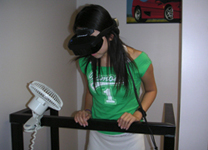Virtual Reality Therapy for Fear of Heights
If you are afraid of heights, you are certainly not alone. In fact, acrophobia, or the fear of heights, is one of the most common phobias, with one-third of the population suffering from this anxiety disorder. Virtual Reality treatment may be the answer you’ve been looking for to get you over your fear!
And while some experts claim that it is a learned response while others believe it is hereditary, none of that matters if you are the one suffering from this debilitating phobia. Those who have a fear of heights may experience nausea, dizziness, vertigo (a spinning or moving sensation), rapid heartbeat, sweating, shortness of breath, and extreme fear when faced with situations involving heights.
You may go to extreme lengths to avoid heights and this is sometimes not feasible. For example, what if your work is on the 25th floor and has huge floor-length windows? Does that mean you cannot work there?
Not according to Dr. Brenda K. Wiederhold, PhD, MBA, President of the Virtual Reality Medical Center (VRMC) in La Jolla, California. VRMC has been providing Virtual Reality therapy for over 2 decades and has had great success in treating many types of phobias and fears. By gradually introducing you to situations such as a glass elevator, bridges, and high buildings through virtual reality, you can be desensitized on your own terms and in your own time. Learning how to think differently and behave differently, you’re able to practice those new skills in VR.
Most individuals with a specific phobia require on average one clinical intake session and 10 treatment sessions. If you live in the San Diego area, you can choose to come once a week or twice a week. If you are coming from out of the area, we can accommodate “condensed treatment” where you will experience one VR session per day, each day, Monday-Friday.


